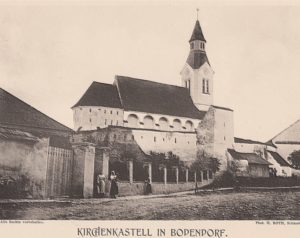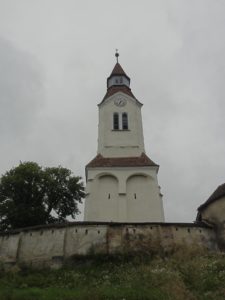Szászbuda

Szászbuda (Bunești, Bodendorf) is located 35 km southeast of Segesvár in Transylvania, Romania. The Saxon fortified church was built in the 14th century in the Romanesque and later Gothic style as a three-nave basilica. In the early 16th century it was surrounded by a defensive wall. Some fragments of the frescoes decorating the walls of the sanctuary can still be seen.

The 13th century late Romanesque pillar basilica was early prepared for battle by demolition of the side naves and fortification of the central nave and the tower by adding defence levels. The fortification wall, originating in the 14th century was strengthen by four towers and had grain storage rooms on the inside.

The municipality of Szászbuda (Budendorf, Buneşti) was mentioned in 1337 as Boda, in 1494 as Bodon, in 1488 as Budendorf, and in 1524 as Bwdendorf. Its church was mentioned in documents as early as 1356. At that time it was a three-nave basilica with a tower. The floor plan is Romanesque, but the sanctuary is already Gothic, with three sides of a polygon, and the arcades between the naves are also pointed arches. The sanctuary was covered by a transept and the nave had a false ceiling.

The chancel was heightened in 1500 by adding a defense level with machicolations. During the fortifications of 1505-1519, the side aisles were demolished and the remaining pillars of the main nave were crowned with a protective tower. The interior walls show traces of the walled arcades. The flat ceilings were replaced by a brick lattice vault. The sanctuary was walled up, leaving only a gap in the nave. The only entrance was on the western façade. The Gothic windows were also restored. A new sacristy was also built at that time.

The tower was built in 1487, but only to the height of the roof. The date of the defensive changes is indicated by a tax concession in the Segesvár tax register from 1505 to 1508: “Dofendorf relaxati ad fabricam ecclesiae fl. 21. den. 12.”

The walls of the sanctuary are decorated with Byzantine-style paintings from the 16th century. Among the apostles, only St. John is recognizable. The beautiful 15th-century chalice with inscriptions comes from a workshop in Brassó. The nave is covered by a star vault.

In 1500 it was surrounded by a five-towered wall and a bastion was added to the front. Its medieval Catholic inhabitants became Lutherans at the Reformation, along with the church. It became a Lutheran mother church in the 18th century and again at the beginning of the 20th century.

Photo: Lánczi Imre
When the village was under attack, the inhabitants took refuge from the looters and arsonists inside the fireproof fortifications. In times of war the massive tower was also serving as a retreat for the priest. The walls are still decorated with words of solace, bearing witness to those terrible times.

Priest Johannes Nösner wrote these faithful words while hiding in the room: “Hör! Hast Vor eIne gVte SaCh, aber`s geht Von statt geMaCh, fahre getrost fort, nICht Verzag, es fäLLt keIn aLt EICh aVff eInn SChlag“ (Listen! You are on the right path, if the going is slow do not despair, no old oak is felled with one stroke). The highlighted letters in the original text are Latin numbers, which add up to the year 1680.

The interior impresses with its tall and narrow proportions, underlined by the two-story balcony on the northern side, erected between 1680 and 1775. The railings were painted by the Roessler family, grandfather and grandson. The 1847 added tower marks the present image of the church.

In 1910 it had 1022 inhabitants, mostly Germans, with a significant Romanian and Gypsy minority. Until the Treaty of Trianon, it belonged to the Kőhalmi district of Nagy-Küküllő county. In 1992, its population of 2252 inhabitants, including its partner settlements, was 1321 Romanians, 587 Gypsies, 260 Germans, and 83 Hungarians.

An EU-funded restoration project of the fortified church was carried out in 2010-2014.
Source: https://kirchenburgen.org/en/location/bodendorf-bunesti/, Wikipedia, and Karczag Ákos-Szabó Tibor: Erdély, Partium és a Bánság erődített helyei (Budapest 2012)

Dear Readers, I can only make this content available through small donations or by selling my books or T-shirts.
If you like my writings, please feel free to support me with a coffee here:
You can check out my books on Amazon or Draft2Digital, they are available in hardcover, paperback, or ebook:
https://www.amazon.com/dp/198020490X or at https://books2read.com/b/boYd81

My work can also be followed and supported on Patreon: Become a Patron!http://Become a Patron!

https://hungarianottomanwars.myspreadshop.com/all
Here are more pictures of Szászbuda:




































































